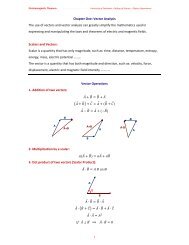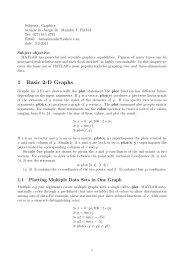Grammatical Aspect in English and Kurdish - University of Sulaimani
Grammatical Aspect in English and Kurdish - University of Sulaimani
Grammatical Aspect in English and Kurdish - University of Sulaimani
Create successful ePaper yourself
Turn your PDF publications into a flip-book with our unique Google optimized e-Paper software.
Actually t <strong>and</strong> d are not aspect markers but they are past tense markers<br />
which are equivalent to the suffix past marker –ed <strong>in</strong> <strong>English</strong>. The<br />
follow<strong>in</strong>g table summarizes the <strong>Kurdish</strong> aspect markers.<br />
Table 1.5 <strong>Kurdish</strong> <strong>Aspect</strong> Systems<br />
<strong>Aspect</strong> mean<strong>in</strong>g Examples<br />
Simple<br />
Perfective<br />
past simple<br />
xward Ø im<br />
Imperfective<br />
present simple da xom<br />
Perfect<br />
Perfective<br />
past perfect<br />
xward bu: m<br />
Imperfective<br />
present perfect xward uma<br />
Progressive Imperfective past cont<strong>in</strong>uous damxard<br />
present cont<strong>in</strong>uous daxom<br />
The above table shows the follow<strong>in</strong>g:<br />
(1) If the prefix –da is not regarded as an aspect marker, the aspectual<br />
dist<strong>in</strong>ctions are expressed by lexical elements, <strong>in</strong> this case it is a present<br />
tense morpheme.<br />
(2) If the prefix –da is regarded as an aspect marker, then all present verb<br />
stems are classified under progressive aspects. In this case the present<br />
tense morpheme is with<strong>in</strong> the verb stem itself.<br />
6. Po<strong>in</strong>ts <strong>of</strong> similarity <strong>and</strong> difference<br />
This section is devoted to the discussion <strong>and</strong> the identification <strong>of</strong><br />
po<strong>in</strong>ts <strong>of</strong> similarity <strong>and</strong> difference <strong>in</strong> the aspectual systems <strong>in</strong> the two<br />
languages.<br />
Similarities:<br />
1- In both languages both aspect <strong>and</strong> tense are related to the time<br />
references. Time is a semantic notion; aspect <strong>and</strong> tense are grammatical<br />
notions. They are grammaticalisations <strong>of</strong> time. Tense refers to the absolute<br />
location <strong>of</strong> an event or action <strong>in</strong> time while aspect refers to how an event or<br />
action is to be viewed with respect to time, rather than to its actual location<br />
<strong>in</strong> time.<br />
2- In both languages, the term aspect refers to the way <strong>of</strong> view<strong>in</strong>g an<br />
<strong>in</strong>ternal temporal constituency <strong>of</strong> a situation .It shows the completion or<br />
the non- completion <strong>of</strong> the action which is described by the verb form.<br />
3- In both languages, two ma<strong>in</strong> types <strong>of</strong> aspect can be dist<strong>in</strong>guished:<br />
marked or unmarked.<br />
4-In both languages, simple, perfect <strong>and</strong> progressive aspects are<br />
dist<strong>in</strong>guished, for <strong>in</strong>stance: (24) a. John eats/ate the apple.<br />
b. John is/was eat<strong>in</strong>g the apple.<br />
c. John has/had eaten the apple.<br />
d. John has/had been eat<strong>in</strong>g the apple.<br />
(25) a. Jon sew daxwat.<br />
b. Jon sewi xwar-Ø-d.<br />
c. Jon sewi xwardi bu:.<br />
d. Jon sewi xwarduwa.<br />
e. Jon sewi daxward ka zangaka leida.<br />
3-<br />
BÑoÐG+/--6Òg?i@Ô+%/2&Ïg@½e+ÑÁ@¾â̺kÒÙÁ?iÒg@¡Ù}

















